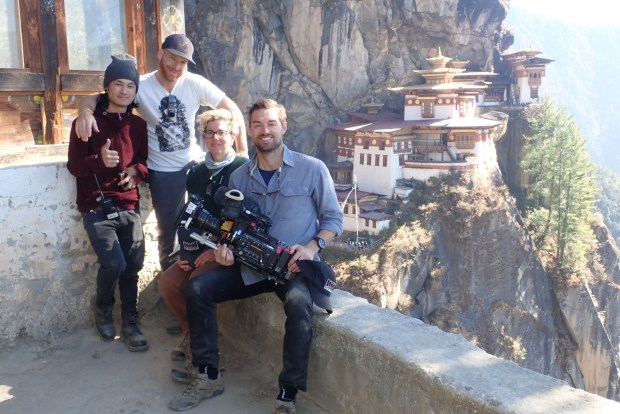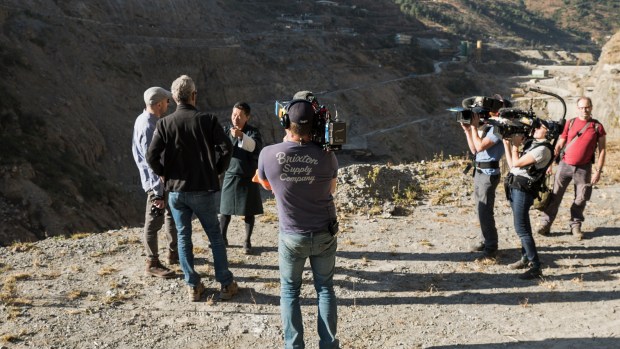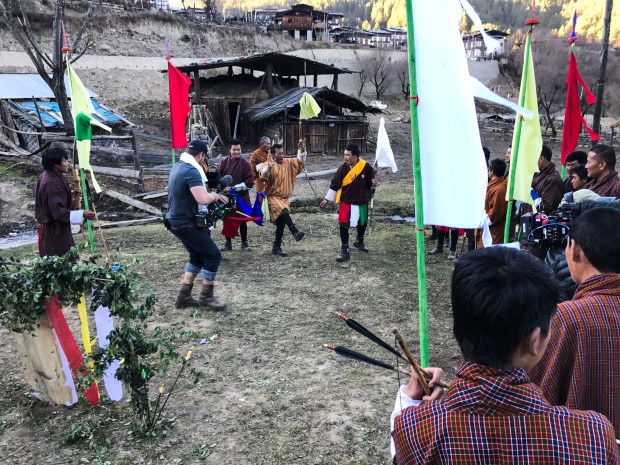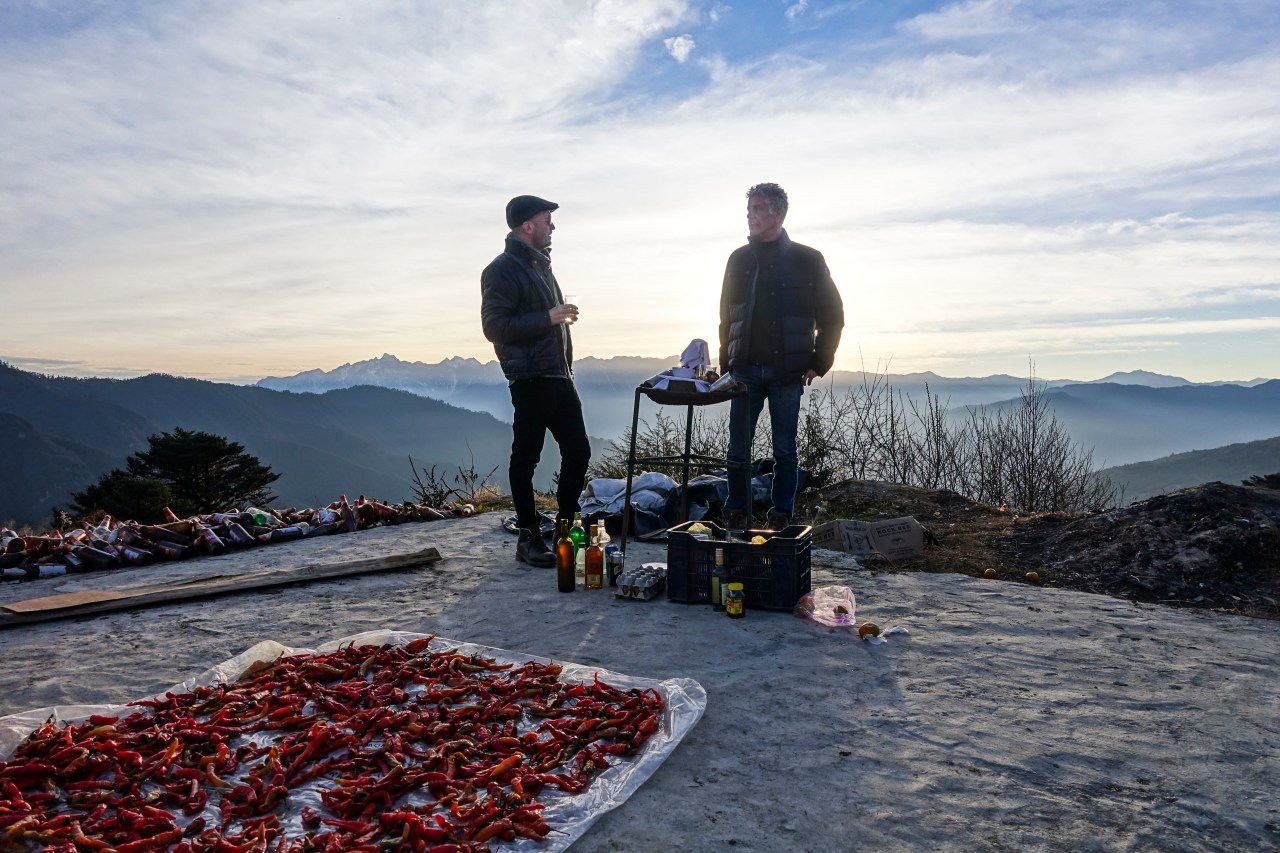Assistant cameraman Joshua Flannigan, who worked on the Bhutan episode, sits down with producer Helen Cho to discuss the challenges of traveling to a remote location, filming at high altitudes, and working with Darren Aronofsky. This interview was conducted before Anthony Bourdain’s death.
Helen Cho: Can you describe what you do as the first assistant cameraman for Parts Unknown?
Joshua Flannigan: It really depends on what day of the shoot we’re on. We’re a relatively small team, so each one of us wears many hats. For example, on travel days I channel the production management team by shepherding the gear through customs, negotiating baggage fees, and convincing airline security that carrying on three huge cameras and a bag full of batteries is perfectly normal.
On our prep days, I do more assistant camera work. I pack around 30 large pelican cases and test all the gear for that episode. We do all the lighting, gripping, and monitoring of sound ourselves. Once we’re rolling, we often need three cameras to properly cover the scenes, so I spend most of those days shooting. Then at night, once we load back into the hotel, I try to bring order by reorganizing our camera bags, charging camera batteries and walkie-talkies. I’ll also start the media management and camera logs. As you can imagine, the days can get pretty long, but I love it.
Cho: Aside from Antarctica, it seems as though Bhutan is up there as one of the more difficult places our crews had to get to. How did you get there, and how long was the trip?
Flannigan: Nothing comes close to the journey it took to get to the South Pole, but getting to Bhutan is definitely second in terms of remoteness and sheer travel time. Door to door, with our 32 cases of film equipment, we were in transit for almost 48 hours.
We flew through Bangkok, and from there, there are only two flights into Bhutan a day. The flight into Paro is one of the most spectacular flights you can take. As you slowly approach the Himalayas, Mount Everest looms in the distance. With some death-defying aerial skills, the pilot meanders his way through the mountain passes onto the tiny runway nestled between these mountains as you’re gripping the armrests. It’s thrilling.
Cho: What kind of challenges did you have finding local crew?

Flannigan: In places like Bhutan, finding a local crew that has experience working with professional cameras and relatively big gear packages is next to impossible. In such remote places, the main thing we’re looking for is a willingness to work hard as well as a desire to learn and a passion for the craft. All the technical stuff can be learned eventually.
Cho: What films or visuals did you reference prior to arriving in Bhutan?
Flannigan: Before a show, I usually like to read up on a country’s history, learn the broad strokes of what the country has been through, and get an idea as to where they are politically. We looked at Bernardo Bertolucci’s Little Buddha, which was filmed mostly in Bhutan and stars a young Keanu Reeves as Siddhartha. We also watched Tony Gatlif’s film Latcho Drom, looking more at the style of shooting as inspiration. Knowing that Darren Aronofsky was going to be the main sidekick on this episode, I ended up also rewatching most of his films, including Pi and Requiem for a Dream.

Cho: As first assistant cameraman, you tend to do a lot of shooting yourself. How did your approach to shooting in Bhutan compare with other places you’ve been?
Flannigan: We were constantly moving and shooting across the country. The further along we went, the bumpier and windier the roads became. At times it took several hours to get to our locations, so we were nauseous and beat up before even beginning to shoot. It was definitely a test of endurance. On the other hand, episodes like Bhutan can be easier to film in certain ways because everything is so unique, and beautiful shots are literally everywhere.
Cho: What is your approach when filming in places where people may not be used to cameras and they’re meeting you for such a short period?
Flannigan: The camera is intimidating. And it’s not just the size. The weight of the millions of potential viewers looking through it can be very daunting. So I never approach someone with the camera blazing, trying to get the shot. I always approach with a smile. Most people are just as interested in whatever I’m doing with this huge hunk of metal as I am interested in them.
I usually have a translator with me to help break the ice, but after years of traveling, one gets pretty good at communicating without words. Ultimately, it’s about respect. Making that personal connection first is crucial. If you’re lucky, even in those fleeting moments, you can create some of the most powerful footage that makes a show.

Cho: What was it like working with Darren Aronofsky? Did he give any direction to our crew in the field?
Flannigan: I was actually expecting him to give us more input as a director while we shot, but he was just as captivated with the place and its people as we were. He seemed to be experiencing the journey as the audience and absorbing what was happening around him, as opposed to being the storyteller, capturing each moment and thinking in very technical terms. Those are two very different ways to experience a place.
Having Darren shut the storyteller side of his brain off and speak to the unique experience he was having was great.
Cho: Tony talks about the ill effects of high altitude in the episode. Did you have to change how you operated to adapt to the altitude?
Flannigan: Definitely. Working at high altitudes is no joke if you’re not acclimated. Since most of us live at sea level, going from zero elevation to almost 8,000 feet in a matter of hours can be very dangerous. Especially when you’re doing what can be a very physical job.
One of our crew members got altitude sickness, had to be hospitalized, and eventually evacuated to lower altitude. When your head is pounding, combined with the delirium you feel from being whipped across 12 time zones onto the top of the highest mountain range in the world, your body basically goes into shock. At a certain point, your body does get used to it, and you can function somewhat normally.

Cho: You’ve been to every continent, though most of that travel happened prior to joining the Parts Unknown crew. What’s left on your bucket list?
Flannigan: You see, my problem is episode jealousy. Even though I do about nine episodes a year, there’s always a level of envy for the shows I don’t do. I’m dying to see places like Iran and Tanzania, but those episodes have been done.
Honestly, when you can say a show has taken you from the remote deserts of the Arabian Peninsula to sitting with the president of the United States in Vietnam to the spacelike South Pole station of Amundsen-Scott, it’s very humbling, and I have nothing but gratitude for being even a small part of this extremely talented team.
This interview has been edited and condensed.